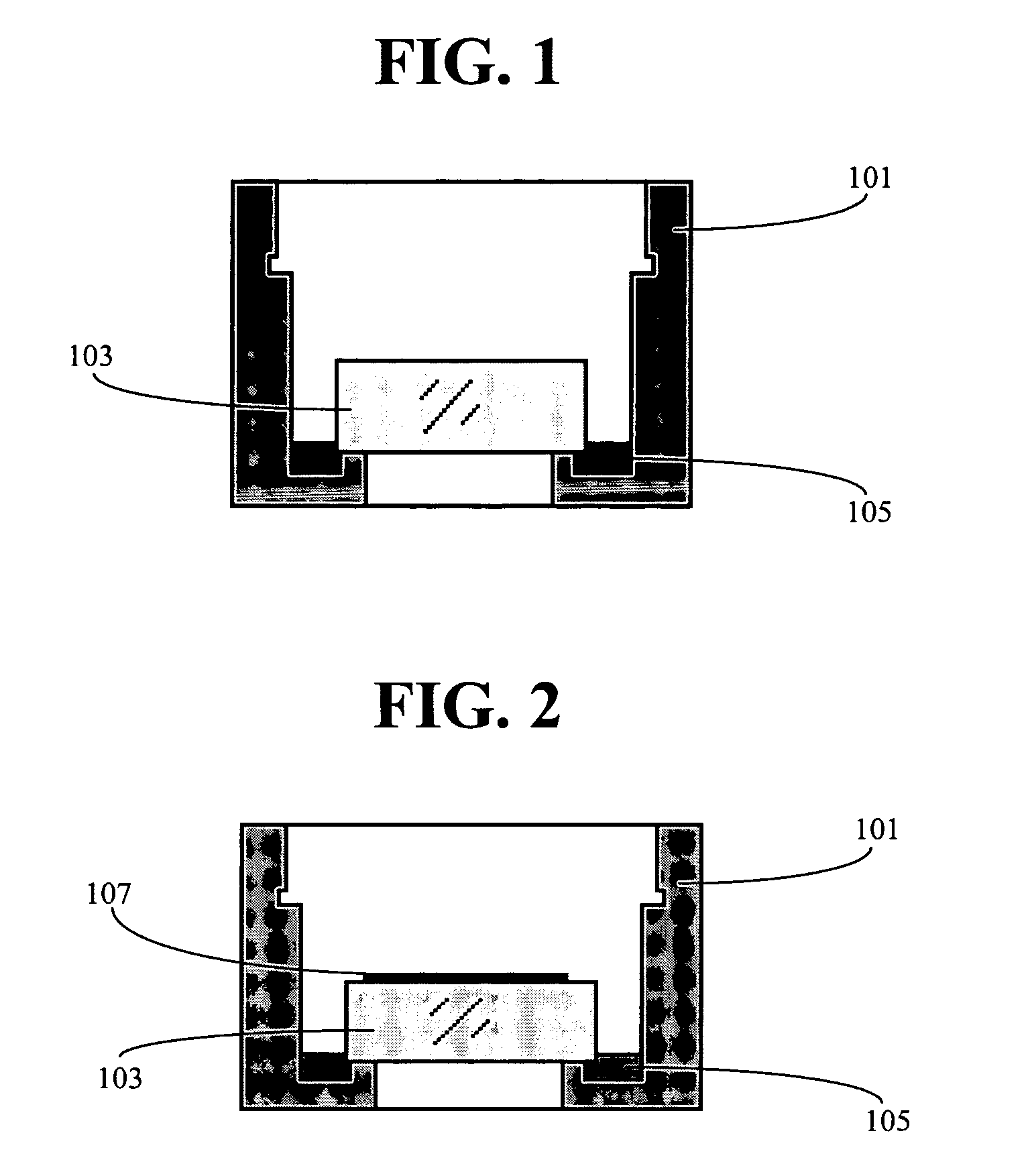Device comprising low outgassing photo or electron beam cured rubbery polymer material
a polymer material and photo or electron beam technology, applied in the field of ultraviolet light or electron beam curable, rubbery materials, can solve the problems of difficult to formulate materials that cure to soft, difficult to achieve low outgassing after cure, and condense outgassed compounds on optical surfaces, etc., to achieve the effect of low outgassing of adhesives
- Summary
- Abstract
- Description
- Claims
- Application Information
AI Technical Summary
Benefits of technology
Problems solved by technology
Method used
Image
Examples
example 1 (
The Present Invention)
[0103]An UV curable composition was prepared by mixing the following components in the following weight percentages:
[0104]
88.00%Kraton Liquid Polymer L-20710.00%1,12-dodecanediol dimethacrylate0.75%Rhodorsil Photoinitiator 20741.00%Esacure KIP 150 from Lamberti SpA0.25%Isopropylthioxanthone
[0105]Kraton Liquid Polymer L-207 is a hetero-telechelic polymer from Kraton Polymers consisting of a hydrogenated polybutadiene polymer that has a primary hydroxyl functionality on one end and an epoxidized isoprene functionality on the other end. The 1,12-dodecanediol dimethacrylate is Mhromomer BM-721 from Rohm America. Rhodorsil Photoinitiator 2074 is (tolylcumyl) iodonium tetrakis (pentafluorophenyl) borate available from Rhodia Inc. Esacure KIP 150 is oligo [2-hydroxy-2-methyl-1-[4-(1-methyl vinyl) phenyl]propane] available from Lamberti SpA. The isopropylthioxanthone is available from Albermarle Corp.
[0106]The viscous liquid mixture was drawn down on a glass plate usin...
example 4 (
The Present Invention)
[0132]The composition in this example demonstrates that pigments can be added to the composition in EXAMPLE 1 to render the liquid material more visible and allow for easier monitoring of the flow of the potting compound before cure. Composition below is in weight percent.
[0133]
87.92%Kraton Liquid Polymer L-20710.00%1,12-dodecanediol dimethacrylate0.75%Rhodorsil 20741.00%Esacure KIP 1500.25%Isopropylthioxanthone0.08%9R445 (24% organic red pigment in TMPTA paste from PennColor Inc.) (TMTPA = Trimethylolpropane triacrylate)
[0134]This composition was used to pot three CaF2 lens elements into a stainless steel housing to test for outgassing on exposure to 157 nm light. The cross-section of one potted lens element is illustrated in FIG. 1. In FIG. 1, 101 is the stainless steel lens housing, 103 is the CaF2 lens element, and 105 is the lens potting material. Three lens elements potted in the same manner were stacked to form a lens assembly. The last element in the st...
example 6 (
The Present Invention)
[0156]A lens potting material was prepared by mixing the following materials in the following weight percentages:
[0157]
98.92%FM003-53 Hydrogenated rubber diacrylate from DesignerMolecules Inc., San Diego, CA0.50%Irgacure 369 from Ciba Geigy Corp., Tarrytown, NY0.25%Isopropylthioxanthone0.25%Speedure PDA from Aceto Corp, Lake Success, NY0.08%9R445 (24% organic red pigment in TMPTA paste fromPennColor, Inc.)Speedure PDA = poly[oxy(methyl-1,2-ethylenediyl), α-(4-dimethylamino)benzoyl-ω-butoxy-]Irgacure 369 = 2-Benzyl-2-N,N-dimethylamino-1-(4-morpholinophenyl)-1-butanone
[0158]This composition and the composition of EXAMPLE 4 were poured into a 1 cm×2 cm×2 mm deep glass mold. The mold was placed in a box with a UV transparent (High Purity Fused Silica) lid and purged with nitrogen. The samples were cured with a Xenon Model RC740 UV lamp source at 10 pulse / sec and 5½ inches (14 cm) height. A separate sample was cured for each of the exposure times listed in TABLE VI ...
PUM
| Property | Measurement | Unit |
|---|---|---|
| Tg | aaaaa | aaaaa |
| wavelength | aaaaa | aaaaa |
| wavelength | aaaaa | aaaaa |
Abstract
Description
Claims
Application Information
 Login to View More
Login to View More - R&D
- Intellectual Property
- Life Sciences
- Materials
- Tech Scout
- Unparalleled Data Quality
- Higher Quality Content
- 60% Fewer Hallucinations
Browse by: Latest US Patents, China's latest patents, Technical Efficacy Thesaurus, Application Domain, Technology Topic, Popular Technical Reports.
© 2025 PatSnap. All rights reserved.Legal|Privacy policy|Modern Slavery Act Transparency Statement|Sitemap|About US| Contact US: help@patsnap.com



